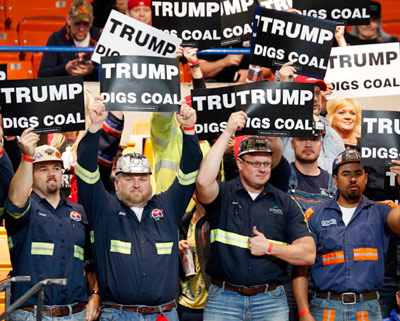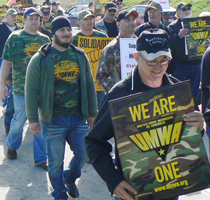
Vol. 80/No. 20 May 23, 2016
(lead article)
Miners’ anger at capitalist crisis marks W.Va primary


Coal miners, above, at May 5 rally for presidential candidate Donald Trump in Charleston, West Virginia. Inset, march of 3,000 miners April 1 in Waynesburg, Pennsylvania, protesting coal bosses’ attempts to gut retirees’ pensions and benefits. Miners are looking for way forward as bosses lay off thousands, attack miners’ union, increase exploitation and make working conditions more dangerous.
Miners’ anger at Clinton’s dismissal of the crisis conditions they face, with some 400 of the state’s 500 mines shut down and 12,000 miners thrown out of work, erupted at a May 2 campaign roundtable in Williamson, West Virginia. “How could you say you are going to put a lot of coal miners out of jobs and then come in here and tell us how you’re going to be our friend?” asked Bo Copley, an unemployed mine foreman.
“What I was saying is the way things are going now, they will continue to lose jobs. It didn’t mean that we were going to do it,” Clinton told him. “I have been talking about helping coal country for a very long time, … and I did put out a plan last summer.”
Clinton’s disdain for workers who face grinding depression conditions — typical of politicians in both the Democratic and Republican parties — is part of what’s fueling the support for the Donald Trump campaign, and to a lesser extent Bernie Sanders, and tearing at the fabric of the two historic bosses’ parties.
“Working people are fed up with politics and business as usual,” Alyson Kennedy, Socialist Workers Party candidate for U.S. president and a former coal miner, told the Militant. “The problem is capitalism, which is in the deepest crisis since the 1930s,” she said. “Trump, Sanders, Clinton and all the rest talk about ‘we’ and ‘us’ and ‘ours’ as if the bosses and workers are all in this together. But there is no we. There is a working class and a capitalist class. We have more in common with workers from around the world than with the bosses here at home.”
A few days after the Clinton roundtable, 13,000 people, including working and unemployed coal miners, high school students and others filled the Charleston Civic Center to hear Trump.
Trump has won workers’ interest by blasting “establishment” politicians of all parties and putting himself forward as a plain talker and successful deal-maker who would bring jobs back to the U.S. According to the Charleston Gazette, “the only thing more common than the red ‘Make America Great Again’ caps that Trump has popularized were the hard hats worn by coal miners.” Signs saying “Trump Digs Coal” were scattered through the crowd.
Friend of coal miners?
Trump portrayed himself as the friend of coal miners. When he put on a miner’s hard hat, the crowd went wild.He was presented with the hat by the coal bosses’ West Virginia Coal Association. And he didn’t say a word about the methane explosions, collapsed roofs and thousands of miners who are once again getting black lung from coal dust as a result of the coal bosses’ profit drive, disregard for safety and antiunion moves.
But the billionaire real estate capitalist wins a hearing because he puts his finger on some of the real problems millions of workers face.
Persistent high unemployment and a decline in real wages are just the tip of the iceberg of the social crisis that is spreading across Appalachia and the rest of the country. Workers in rural areas and small towns that have been devastated by mine, mill and factory closings are among the hardest hit. For the first time in decades, life expectancy in the U.S. is in decline. A report in 2015 said that West Virginia had the highest drug overdose death rate in the U.S.
These stark facts have spawned a series of articles in the Washington Post and other papers that blame the workers themselves for their growing addiction to opioid drugs and heroin, alcoholism and increased suicide rates. An April 8 Post feature was headlined, “‘We Don’t Know Why It Came to This.’ As white women between 25 and 55 die at spiking rates, a close look at one tragedy.”
Living conditions are worse for most workers who are Black. But gains made since the mass working-class struggle for Black rights overthrew Jim Crow segregation in the 1960s and ’70s have meant infant mortality, homicide and mortality rates have been declining over the last decade for African Americans. As a result, according to the May 8 New York Times, the gap between Black and white life expectancy was seven years in 1990, but had shrunk to 3.4 years by 2014.
Self-serving rationalizations for the economic crisis are less convincing to many working people than ever. A May 1 New York Times magazine article by the paper’s financial correspondent Andrew Ross Sorkin on President Barack Obama’s “economic legacy” notes that “few Americans seem to be celebrating” what Obama claims is the best managed “large economy on Earth in modern history.”
Obama blames Republican badmouthing of his “accomplishments” and the ignorance of working people for the lack of enthusiasm for his legacy. But Sorkin admits that average annual household income in the U.S. is $4,000 less than it was in 2001.
Fear of working class
The news media is awash with articles attacking Trump and reporting on the turmoil in the Republican Party. But the real target is not his program or lack thereof, which, as former opponent Ted Cruz put it, is really just “New York values.” It’s not a radical departure from normal bourgeois politics. The attacks reflect the fear that sections of the ruling class — Democrat and Republican, conservative and liberal alike — have of the hundreds of thousands of working people who show up at his rallies, embracing his denunciation of Washington and the politicians who carry on business as usual as the economic and social crisis deepens. This is especially true of workers the pundits view as “white trash.”“The dangerous nihilism of Trump voters” was the headline on a May 4 opinion piece by Charles Lane in the Washington Post. You can blame the Republican establishment “for taking Trump too lightly,” Lane says. “But there hasn’t been nearly enough blaming of the people most responsible for The Donald’s rise: his voters.”
The liberal New York Daily News projected a similar fear of workers in its May 4 featured editorial page cartoon. It depicts Trump supporters as zombies wearing “Make America Great Again” T-shirts.
More than any other candidate Trump speaks about the “working class.” He says his record as a successful businessman shows he can negotiate hard, push American nationalism and create jobs. And he skewers politics as usual.
“Does he get angry? Yes,” Bill Johnson, a cook and veteran told the London Financial Times at Trump’s May 8 rally in Charleston. “Does he say silly things? Yes. But he’s a human being. He says what he feels.”
Trump recently backed off his opposition to raising the minimum wage, while promising that the jobs he creates will pay “much, much more” than that.
‘The stress of poverty’
Meanwhile Sanders, who won the Democratic primary in West Virginia May 10, continues to be a thorn in Clinton’s quest to be the chief executive officer of U.S. imperialism, increasing turmoil in the Democratic Party with his call to build a “movement” that would continue beyond the elections. In Kimball, West Virginia, Sanders spoke at a local food bank May 5. “When you don’t have any money you’re fighting for survival every day,” Sanders said. He said the increased death and addiction rates in West Virginia are caused by the “stress of poverty.”“What is strange about what goes on in America is that we are the wealthiest country in the history of the world,” Sanders said. Like Trump he blamed bad trade deals for high unemployment and said he would create jobs.
“The SWP joins workers in fighting against the employers’ attacks on our jobs, wages, working conditions and deteriorating social conditions,” SWP presidential candidate Kennedy said. “We urge the unions to lead a fight for a massive government-funded public works program to put people to work at union wages, rebuilding crumbling infrastructure, hospitals, child care centers, schools, parks and other things workers need.
“No matter who is elected president, the capitalist crisis will continue,” she said. “The capitalist economy can’t be regulated or ‘managed.’ The working class must organize by the millions to overthrow the rule of the bosses and replace it with a workers and farmers government to control our own destiny.”
Related articles:
‘Workers in power would ensure miners jobs, safety’
Front page (for this issue) | Home | Text-version home